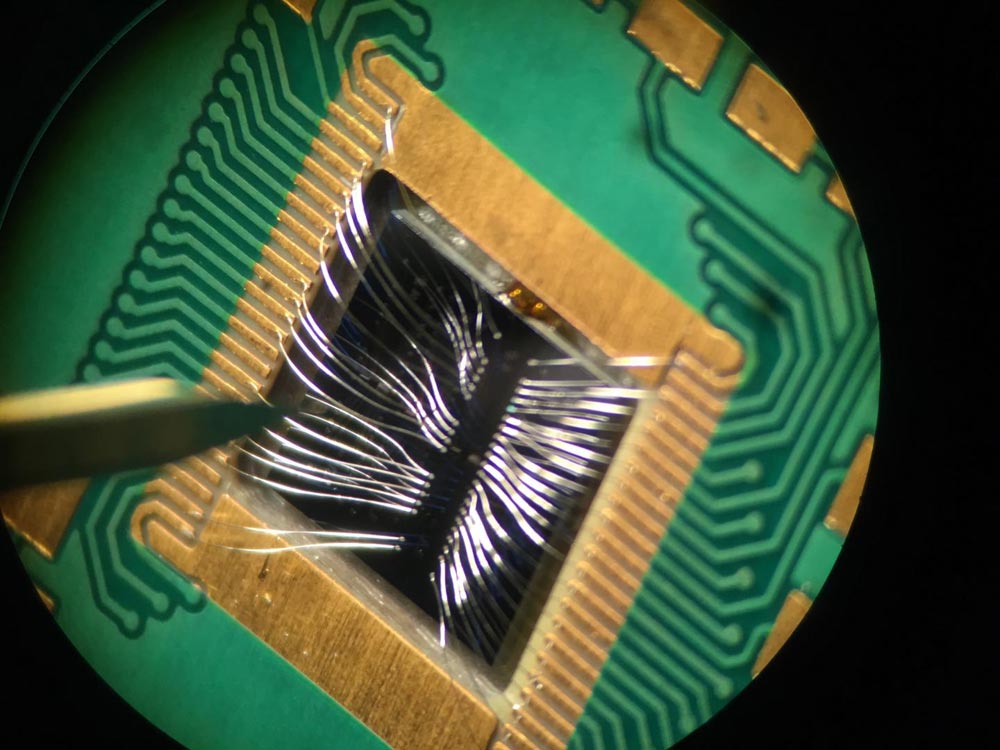
New Silicon Structure Unlocks Quantum Computing Potential

The researchers demonstrated the ability to control with precision the behavior of two silicon-based quantum bits, or qubits, paving the way for making complex, multi-qubit devices using technology that is less expensive and easier to manufacture than other approaches.
Image credit: David Zajac, Princeton University
The team constructed a gate that controls interactions between the electrons in a way that allows them to act as the quantum bits of information, or qubits, necessary for quantum computing. The demonstration of this nearly error-free, two-qubit gate is an important early step in building a more complex quantum computing device from silicon, the same material used in conventional computers and smartphones.
“We knew we needed to get this experiment to work if silicon-based technology was going to have a future in terms of scaling up and building a quantum computer,” said Jason Petta, a professor of physics at Princeton University. “The creation of this high-fidelity two-qubit gate opens the door to larger scale experiments.”
Silicon-based devices are likely to be less expensive and easier to manufacture than other technologies for achieving a quantum computer. Although other research groups and companies have announced quantum devices containing 50 or more qubits, those systems require exotic materials such as superconductors or charged atoms held in place by lasers.
Quantum computers can solve problems that are inaccessible with conventional computers. The devices may be able to factor extremely large numbers or find the optimal solutions for complex problems. They could also help researchers understand the physical properties of extremely small particles such as atoms and molecules, leading to advances in areas such as materials science and drug discovery.
Building a quantum computer requires researchers to create qubits and couple them to each other with high fidelity. Silicon-based quantum devices use a quantum property of electrons called “spin” to encode information. The spin can point either up or down in a manner analogous to the north and south poles of a magnet. In contrast, conventional computers work by manipulating the electron's negative charge.
Achieving a high-performance, spin-based quantum device has been hampered by the fragility of spin states — they readily flip from up to down or vice versa unless they can be isolated in a very pure environment. By building the silicon quantum devices in Princeton's Quantum Device Nanofabrication Laboratory, the researchers were able to keep the spins coherent — that is, in their quantum states — for relatively long periods of time.
To construct the two-qubit gate, the researchers layered tiny aluminum wires onto a highly ordered silicon crystal. The wires deliver voltages that trap two single electrons, separated by an energy barrier, in a well-like structure called a double quantum dot.
By temporarily lowering the energy barrier, the researchers allow the electrons to share quantum information, creating a special quantum state called entanglement. These trapped and entangled electrons are now ready for use as qubits, which are like conventional computer bits but with superpowers: while a conventional bit can represent a zero or a 1, each qubit can be simultaneously a zero and a 1, greatly expanding the number of possible permutations that can be compared instantaneously.
“The challenge is that it's very difficult to build artificial structures small enough to trap and control single electrons without destroying their long storage times,” said David Zajac, a graduate student in physics at Princeton and first-author on the study. “This is the first demonstration of entanglement between two electron spins in silicon, a material known for providing one of the cleanest environments for electron spin states.”
The researchers demonstrated that they can use the first qubit to control the second qubit, signifying that the structure functioned as a controlled NOT (CNOT) gate, which is the quantum version of a commonly used computer circuit component. The researchers control the behavior of the first qubit by applying a magnetic field. The gate produces a result based on the state of the first qubit: If the first spin is pointed up, then the second qubit's spin will flip, but if the first spin is down, the second one will not flip.
“The gate is basically saying it is only going to do something to one particle if the other particle is in a certain configuration,” Petta said. “What happens to one particle depends on the other particle.”
The researchers showed that they can maintain the electron spins in their quantum states with a fidelity exceeding 99 percent and that the gate works reliably to flip the spin of the second qubit about 75 percent of the time. The technology has the potential to scale to more qubits with even lower error rates, according to the researchers.
“This work stands out in a worldwide race to demonstrate the CNOT gate, a fundamental building block for quantum computation, in silicon-based qubits,” said HongWen Jiang, a professor of physics and astronomy at the University of California-Los Angeles. “The error rate for the two-qubit operation is unambiguously benchmarked. It is particularly impressive that this extraordinarily difficult experiment, which requires a sophisticated device fabrication and an exquisite control of quantum states, is done in a university lab consisting of only a few researchers.”
###
Additional researchers at Princeton are graduate student Felix Borjans and associate research scholar Anthony Sigillito. The team included input on the theory aspects of the work by Jacob Taylor, a professor at the Joint Quantum Institute and Joint Center for Quantum Information and Computer Science at the National Institute of Standards and Technology and the University of Maryland, and Maximilian Russ and Guido Burkard at the University of Konstanz in Germany.
Research was sponsored by U.S. Army Research Office grant W911NF-15-1-0149, the Gordon and Betty Moore Foundation's EPiQS Initiative through grant GBMF4535, and National Science Foundation grant DMR-1409556. Devices were fabricated in the Princeton University Quantum Device Nanofabrication Laboratory.












